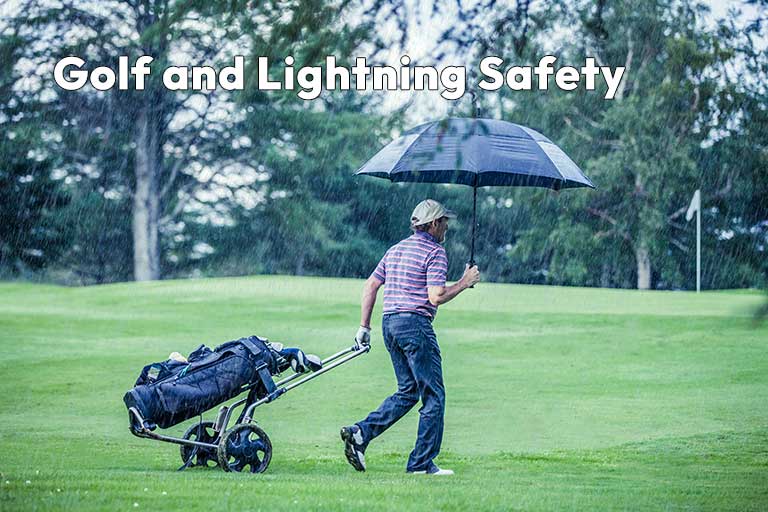Table of Contents
Golfers are a stubborn bunch. And I can say this with some authority, having spent countless hours on the course myself. There’s a peculiar allure to the game that makes us want to brave the elements, come rain or shine. But when it comes to thunder and lightning, the stakes are too high to gamble with. It’s not just about getting wet or having your game interrupted; its about life and death. The fact is, lightning is no respecter of skill level, handicap, or enthusiasm. It can strike anywhere and at any time, turning a leisurely day on the green into a potential disaster.
Golfers must be aware that the open expanses of a golf course make them particularly vulnerable to lightning strikes. According to the National Weather Service, about 10% of lightning strike victims are killed, and 70% suffer serious long-term effects. With statistics like these, its astonishing how many golfers underestimate the risks. The scenario is all too familiar: dark clouds roll in, a distant rumble is heard, and instead of heading for safety, many of us are tempted to hit just one more hole. But let me be clear: when thunder roars, head indoors.
Golf and Lightning Safety Tips
Learn how to stay safe during thunderstorms while golfing. – Understand the signs of an impending storm and know when to leave the course to avoid lightning hazards. – Familiarize yourself with lightning safety protocols for golfers, including seeking shelter and staying indoors until its safe. – Discover how golf course design impacts safety measures and management during severe weather.
Lightning Safety for Golfers
Experiencing a thunderstorm while on the course is something that stays with you. I recall a particular afternoon at a local club when the sky turned an ominous shade of gray. The air was thick, charged with that electrifying tension that precedes a storm. Despite the warning signs, a fellow golfer insisted on finishing the round. It wasn’t until a bolt of lightning struck a tree not far from the 15th hole that we all realized the folly of our stubbornness.
The National Golf Course Owners Association (NGCOA) emphasizes the importance of implementing lightning safety protocols. These include utilizing weather apps and lightning detection systems. Yet, the most crucial tool a golfer can have is common sense. If you see lightning or hear thunder, it’s time to seek shelter immediately. This isn’t a matter of overreacting; its a matter of survival.
Insider Tip: Always have a weather app installed on your phone that can alert you to approaching storms. Many of these apps provide real-time updates on lightning strikes and can be lifesavers on the golf course.
The unpredictability of lightning makes it imperative to act quickly. Its recommended that golfers familiarize themselves with the location of designated shelters on the course. Clubhouses, restrooms, and maintenance buildings often serve as safe havens. Avoid open areas, tall trees, and metal objects, including golf clubs and carts, which can attract lightning.
For those who take their game seriously, it’s worth noting that lightning-related delays can be built into the schedule. Many professional tournaments have backup plans for such eventualities. Recreational golfers should adopt similar strategies, planning extra time for potential delays and always prioritizing safety over scorecards.
A Personal Encounter with Lightning on the Golf Course
As an avid golfer, I often found solace on the lush greens of my local course. One summer afternoon, I was playing a round with my friends when dark clouds unexpectedly rolled in. Ignoring the warning signs, we decided to finish the hole we were playing.
Suddenly, a loud clap of thunder echoed across the sky, and the air felt charged with electricity. It was then that I remembered the safety protocols I had read about: “Seek shelter immediately.” As I looked around, I saw other golfers continuing their games, blissfully unaware of the impending danger.
Just as we sprinted toward the clubhouse, a bolt of lightning struck a nearby tree, splintering it and sending debris flying. I could hardly believe how close we came to a potentially tragic outcome. Thankfully, we made it to safety just in time, but the experience shook me to my core.
This incident taught me an invaluable lesson about lightning safety while golfing. Now, I’m an advocate for always checking the weather before heading out and encouraging fellow golfers to take the threat of lightning seriously. Its a reminder that nature can be unpredictable, and its crucial to prioritize safety over the game.
Golf Course Design and Management
The responsibility for safety doesn’t rest solely on the shoulders of golfers. Golf course design and management play a critical role in ensuring a safe environment. A well-designed course incorporates multiple shelters strategically placed to provide refuge from sudden storms. Yet, it’s surprising how many courses overlook this basic need.
In my years on the links, Ive seen the difference good management can make. Courses that invest in comprehensive lightning detection systems and regular safety drills create a culture of awareness. They also establish clear procedures for evacuating the course, ensuring all players and staff know what to do when weather conditions threaten.
Insider Tip: If you’re considering joining a new club or playing a course for the first time, inquire about their lightning safety measures. A course that takes safety seriously will have no qualms discussing their protocols with you.
Moreover, course management should conduct regular reviews and updates of their safety protocols. This includes training staff to handle emergencies efficiently and ensuring maintenance teams keep shelters in good condition. The NGCOA provides numerous resources for course owners to enhance their safety standards, including guidelines for integrating technology and improving communication systems.
One innovative approach some courses have adopted is the use of sirens or horn systems that sound when lightning is detected within a certain radius. This auditory warning system ensures that everyone on the course is aware of the danger, even if they’re not near their phones or other devices.
Conclusion
In the end, the message is clear: when it comes to thunder and lightning, the only sensible choice is to get off the course and stay safe. Golf is a game of patience and strategy, and sometimes the best strategy is to wait it out. With the right precautions and a commitment to safety, you can enjoy the game for many years to come. Remember, no round of golf is worth risking your life over. So, the next time you hear that distant rumble, don’t hesitate. Head for cover, and live to play another day.
Questions
When should I get off the course during a thunderstorm?
You should leave the course immediately at the first signs of thunder.
What are the safest shelters during lightning storms?
The safest shelters include buildings or fully enclosed vehicles.
How can I stay safe while outdoors during a thunderstorm?
Stay away from tall objects and find shelter until the storm passes.
Who should I call if I feel unsafe during outdoor storms?
You should call local authorities or emergency services for assistance.
What if I’m far from shelter when a storm hits?
Find low ground, avoid trees, and stay low until the storm passes.
Why should I take thunderstorm warnings seriously while outdoors?
Ignoring warnings can lead to serious injury or even death from lightning.





